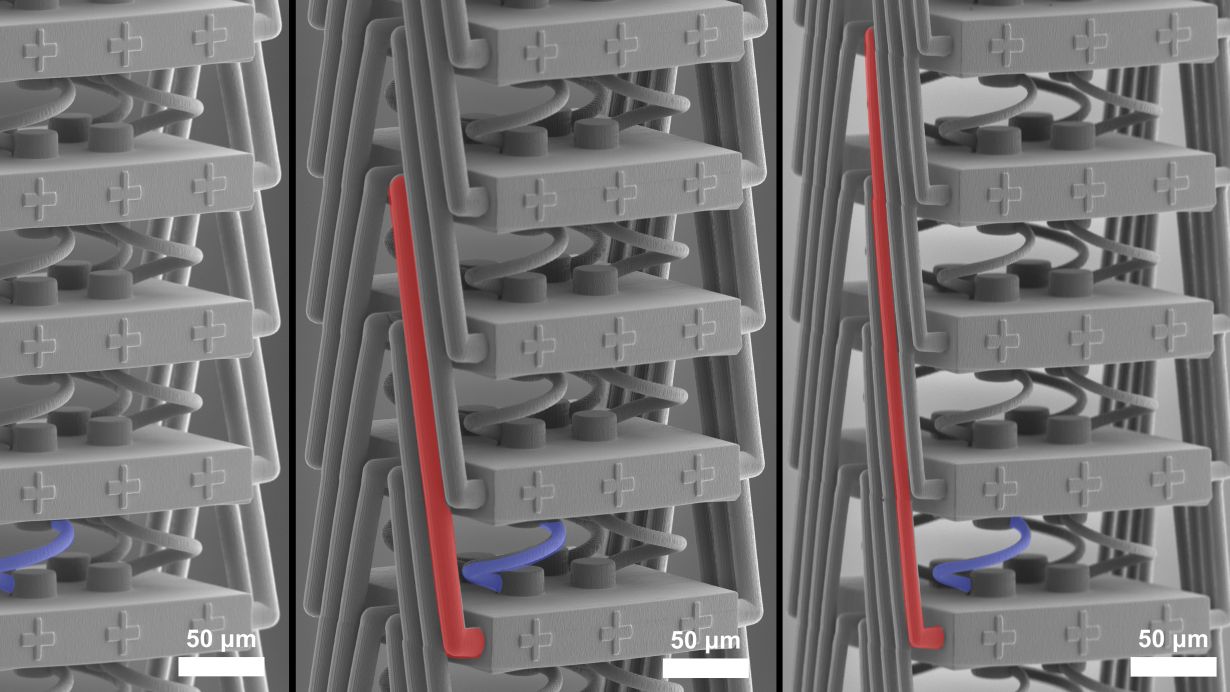
Metamaterials are artificial materials that do not occur in nature. Their components function like atoms in conventional materials but have special optical, electrical and magnetic properties. Interaction between the components is crucial to a metamaterial's functionality. Previously a component could usually interact only with its immediate neighbors. Researchers at the Karlsruhe Institute of Technology (KIT) have developed a mechanical metamaterial with which these interactions can also be triggered at greater distances within the material. Potential uses of the material include measuring forces and structural monitoring. The findings have been published in Nature Communications. (DOI: 10.1038/s41467-024-52956-5) .
With this material, the working group headed by Professor Martin Wegener at KIT's Institute of Applied Physics (APH) has overcome a limitation of metamaterials. Lead author Dr. Yi Chen compares this with human communication and an effect known from the "telephone game": When people communicate through a chain of intermediaries, the message received by the last person can be completely different than if the first and last people had spoken to each other directly. According to Chen, this principle also applies to metamaterials. "The material we designed has special structures (red in the illustration). With these structures, individual components no longer 'communicate' only via their neighbors with components farther away, now they can also communicate directly with all other components in the material," Chen said.
Experiments on 3D-printed Microscopic Samples
"These structures give the material fascinating properties such as unusual stretching characteristics," said co-author Ke Wang, also from the APH. The team was able to show this with micron-sized samples of the material, which they produced using 3D laser printing technology and examined with a camera-equipped microscope. Their analysis showed that a one-dimensional (1D) beam stretched in an irregular manner when pulled from one end.
In contrast to an object such as a rubber band, which stretches uniformly when pulled, the metamaterial actually exhibited compression in some places, while some short sections stretched more than longer sections even though the same force was applied throughout. "This unusual behavior with locally occurring stretching and compression is impossible in conventional materials," said Jonathan Schneider of APH, another co-author. "Now we will investigate this in two-dimensional (planar) and three-dimensional materials."
The metamaterial is extremely sensitive to loads, which could be a potentially useful property. Depending on the point at which force is applied in the material, completely different stretching reactions can result even at relatively distant points. According to the researchers, reactions in conventional materials are only observed directly at the point where force is applied, while only weak or negligible effects can be identified at distant locations in the material. A material with this sensitivity could be valuable for engineering applications in which large-scale forces need to be measured, as in monitoring building deformations, or in biological research to characterize forces in cells.
This research was supported by KIT's 3D Matter Made to Order (3DMM2O) Cluster of Excellence and Heidelberg University.
Original publication:
Yi Chen, Jonathan L.G. Schneider, Ke Wang, Philip Scott, Sebastian Kalt, Muamer Kadic, Martin Wegener: Anomalous frozen evanescent phonons, Nature Communications, 2024 DOI: 10.1038/s41467-024-52956-5
Being "The Research University in the Helmholtz Association", KIT creates and imparts knowledge for the society and the environment. It is the objective to make significant contributions to the global challenges in the fields of energy, mobility, and information. For this, about 10,000 employees cooperate in a broad range of disciplines in natural sciences, engineering sciences, economics, and the humanities and social sciences. KIT prepares its 22,800 students for responsible tasks in society, industry, and science by offering research-based study programs. Innovation efforts at KIT build a bridge between important scientific findings and their application for the benefit of society, economic prosperity, and the preservation of our natural basis of life. KIT is one of the German universities of excellence.






